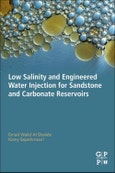Low Salinity and Engineered Water Injection for Sandstone and Carbonate Reservoirs provides a first of its kind review of the low salinity and engineered water injection (LSWI/EWI) techniques for today's more complex enhanced oil recovery methods. Reservoir engineers today are challenged in the design and physical mechanisms behind low salinity injection projects, and to date, the research is currently only located in numerous journal locations. This reference helps readers overcome these challenging issues with explanations on models, experiments, mechanism analysis, and field applications involved in low salinity and engineered water.
Covering significant laboratory, numerical, and field studies, lessons learned are also highlighted along with key areas for future research in this fast-growing area of the oil and gas industry. After an introduction to its techniques, the initial chapters review the main experimental findings and explore the mechanisms behind the impact of LSWI/EWI on oil recovery. The book then moves on to the critical area of modeling and simulation, discusses the geochemistry of LSWI/EWI processes, and applications of LSWI/EWI techniques in the field, including the authors' own recommendations based on their extensive experience.
It is an essential reference for professional reservoir and field engineers, researchers and students working on LSWI/EWI and seeking to apply these methods for increased oil recovery.
Please Note: This is an On Demand product, delivery may take up to 11 working days after payment has been received.
Table of Contents
1. Introduction about LSWI/EWI2. Experimental Works on LSWI/EWI
3. Mechanisms behind LSWI/EWI Effect on Oil Recovery
4. Modeling of the LSWI/EWI Technique in Sandstones and Carbonates
5. Geochemistry of LSWI/EWI Processes
6. Other Applications of LSWI/EWI in Sandstones and Carbonates
7. Field Applications of LSWI/EWI
8. Comparison of LSWI/EWI Effect on Sandstone and Carbonate Rocks
9. Concluding Remarks








